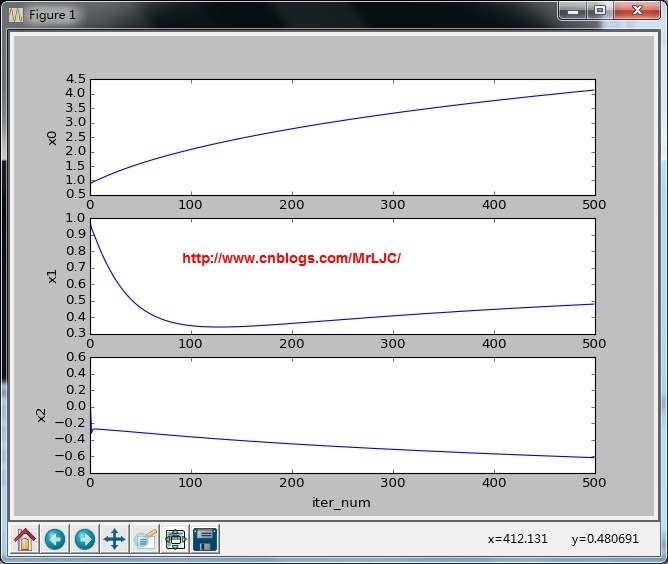Logistic回归 python实现
Logistic回归
算法优缺点:
1.计算代价不高,易于理解和实现
2.容易欠拟合,分类精度可能不高
3.适用数据类型:数值型和标称型
算法思想:
- 其实就我的理解来说,logistic回归实际上就是加了个sigmoid函数的线性回归,这个sigmoid函数的好处就在于,将结果归到了0到1这个区间里面了,并且sigmoid(0)=0.5,也就是说里面的线性部分的结果大于零小于零就可以直接计算到了。这里的求解方式是梯度上升法,具体我就不扯了,最推荐的资料还是Ng的视频,那里面的梯度下降就是啦,只不过一个是梯度上升的方向一个是下降的方向,做法什么的都一样。
- 而梯度上升(准确的说叫做“批梯度上升”)的一个缺点就是计算量太大了,每一次迭代都需要把所有的数据算一遍,这样一旦训练集大了之后,那么计算量将非常大,所以这里后面还提出了随机梯度下降,思想就是每次只是根据一个data进行修正。这样得到的最终的结果可能会有所偏差但是速度却提高了很多,而且优化之后的偏差还是很小的。随机梯度上升的另一个好处是这是一个在线算法,可以根据新数据的到来不断处理
函数:
loadDataSet()
创建数据集,这里的数据集就是在一个文件中,这里面有三行,分别是两个特征和一个标签,但是我们在读出的时候还加了X0这个属性sigmoid(inX)
sigmoid函数的计算,这个函数长这样的,基本坐标大点就和阶跃函数很像了

gradAscend(dataMatIn, classLabels)
梯度上升算法的实现,里面用到了numpy的数组,并且设定了迭代次数500次,然后为了计算速度都采取了矩阵计算,计算的过程中的公式大概是:w= w+alpha*(y-h)x[i](一直懒得写公式,见谅。。。)gradAscendWithDraw(dataMatIn, classLabels)
上面的函数加强版,增加了一个weight跟着迭代次数的变化曲线stocGradAscent0(dataMatrix, classLabels)
这里为了加快速度用来随机梯度上升,即每次根据一组数据调整(额,好吧,这个际没有随机因为那是线面那个函数)stocGradAscentWithDraw0(dataMatrix, classLabels)
上面的函数加强版,增加了一个weight跟着迭代次数的变化曲线stocGradAscent1(dataMatrix, classLabels, numIter=150)
这就真的开始随机了,随机的主要好处是减少了周期性的波动了。另外这里还加入了alpha的值随迭代变化,这样可以让alpha的值不断的变化,但是都不会减小到0。stocGradAscentWithDraw1(dataMatrix, classLabels, numIter=150)
上面的函数加强版,增加了一个weight跟着迭代次数的变化曲线plotBestFit(wei)
根据计算的weight值画出拟合的线,直观观察效果
迭代变化趋势
分类结果:
迭代变化趋势分类结果:这个速度虽然快了很多但是效果不太理想啊。不过这个计算量那么少,我们如果把这个迭代200次肯定不一样了,效果如下果然好多了
迭代变化趋势分类结果:恩,就是这样啦,效果还是不错的啦。代码的画图部分写的有点烂,见谅啦
#coding=utf-8
from numpy import * def loadDataSet():
dataMat = []
labelMat = []
fr = open('testSet.txt')
for line in fr.readlines():
lineArr = line.strip().split()
dataMat.append([1.0, float(lineArr[0]), float(lineArr[1])])
labelMat.append(int(lineArr[2]))
return dataMat, labelMat def sigmoid(inX):
return 1.0/(1+exp(-inX)) def gradAscend(dataMatIn, classLabels):
dataMatrix = mat(dataMatIn)
labelMat = mat(classLabels).transpose()
m,n = shape(dataMatrix)
alpha = 0.001
maxCycle = 500
weight = ones((n,1))
for k in range(maxCycle):
h = sigmoid(dataMatrix*weight)
error = labelMat - h
weight += alpha * dataMatrix.transpose() * error
#plotBestFit(weight)
return weight def gradAscendWithDraw(dataMatIn, classLabels):
import matplotlib.pyplot as plt
fig = plt.figure()
ax = fig.add_subplot(311,ylabel='x0')
bx = fig.add_subplot(312,ylabel='x1')
cx = fig.add_subplot(313,ylabel='x2')
dataMatrix = mat(dataMatIn)
labelMat = mat(classLabels).transpose()
m,n = shape(dataMatrix)
alpha = 0.001
maxCycle = 500
weight = ones((n,1))
wei1 = []
wei2 = []
wei3 = []
for k in range(maxCycle):
h = sigmoid(dataMatrix*weight)
error = labelMat - h
weight += alpha * dataMatrix.transpose() * error
wei1.extend(weight[0])
wei2.extend(weight[1])
wei3.extend(weight[2])
ax.plot(range(maxCycle), wei1)
bx.plot(range(maxCycle), wei2)
cx.plot(range(maxCycle), wei3)
plt.xlabel('iter_num')
plt.show()
return weight def stocGradAscent0(dataMatrix, classLabels):
m,n = shape(dataMatrix) alpha = 0.001
weight = ones(n)
for i in range(m):
h = sigmoid(sum(dataMatrix[i]*weight))
error = classLabels[i] - h
weight = weight + alpha * error * dataMatrix[i]
return weight def stocGradAscentWithDraw0(dataMatrix, classLabels):
import matplotlib.pyplot as plt
fig = plt.figure()
ax = fig.add_subplot(311,ylabel='x0')
bx = fig.add_subplot(312,ylabel='x1')
cx = fig.add_subplot(313,ylabel='x2')
m,n = shape(dataMatrix) alpha = 0.001
weight = ones(n)
wei1 = array([])
wei2 = array([])
wei3 = array([])
numIter = 200
for j in range(numIter):
for i in range(m):
h = sigmoid(sum(dataMatrix[i]*weight))
error = classLabels[i] - h
weight = weight + alpha * error * dataMatrix[i]
wei1 =append(wei1, weight[0])
wei2 =append(wei2, weight[1])
wei3 =append(wei3, weight[2])
ax.plot(array(range(m*numIter)), wei1)
bx.plot(array(range(m*numIter)), wei2)
cx.plot(array(range(m*numIter)), wei3)
plt.xlabel('iter_num')
plt.show()
return weight def stocGradAscent1(dataMatrix, classLabels, numIter=150):
m,n = shape(dataMatrix) #alpha = 0.001
weight = ones(n)
for j in range(numIter):
dataIndex = range(m)
for i in range(m):
alpha = 4/ (1.0+j+i) +0.01
randIndex = int(random.uniform(0,len(dataIndex)))
h = sigmoid(sum(dataMatrix[randIndex]*weight))
error = classLabels[randIndex] - h
weight = weight + alpha * error * dataMatrix[randIndex]
del(dataIndex[randIndex])
return weight def stocGradAscentWithDraw1(dataMatrix, classLabels, numIter=150):
import matplotlib.pyplot as plt
fig = plt.figure()
ax = fig.add_subplot(311,ylabel='x0')
bx = fig.add_subplot(312,ylabel='x1')
cx = fig.add_subplot(313,ylabel='x2')
m,n = shape(dataMatrix) #alpha = 0.001
weight = ones(n)
wei1 = array([])
wei2 = array([])
wei3 = array([])
for j in range(numIter):
dataIndex = range(m)
for i in range(m):
alpha = 4/ (1.0+j+i) +0.01
randIndex = int(random.uniform(0,len(dataIndex)))
h = sigmoid(sum(dataMatrix[randIndex]*weight))
error = classLabels[randIndex] - h
weight = weight + alpha * error * dataMatrix[randIndex]
del(dataIndex[randIndex])
wei1 =append(wei1, weight[0])
wei2 =append(wei2, weight[1])
wei3 =append(wei3, weight[2])
ax.plot(array(range(len(wei1))), wei1)
bx.plot(array(range(len(wei2))), wei2)
cx.plot(array(range(len(wei2))), wei3)
plt.xlabel('iter_num')
plt.show()
return weight def plotBestFit(wei):
import matplotlib.pyplot as plt
weight = wei
dataMat,labelMat = loadDataSet()
dataArr = array(dataMat)
n = shape(dataArr)[0]
xcord1 = []
ycord1 = []
xcord2 = []
ycord2 = []
for i in range(n):
if int(labelMat[i]) == 1:
xcord1.append(dataArr[i,1])
ycord1.append(dataArr[i,2])
else:
xcord2.append(dataArr[i,1])
ycord2.append(dataArr[i,2])
fig = plt.figure()
ax = fig.add_subplot(111)
ax.scatter(xcord1, ycord1, s=30, c='red', marker='s')
ax.scatter(xcord2, ycord2, s=30, c='green')
x = arange(-3.0, 3.0, 0.1)
y = (-weight[0] - weight[1]*x)/weight[2]
ax.plot(x,y)
plt.xlabel('X1')
plt.ylabel('X2')
plt.show() def main():
dataArr,labelMat = loadDataSet()
#w = gradAscendWithDraw(dataArr,labelMat)
w = stocGradAscentWithDraw0(array(dataArr),labelMat)
plotBestFit(w) if __name__ == '__main__':
main()机器学习笔记索引
Logistic回归 python实现的更多相关文章
- Logistic回归python实现
2017-08-12 Logistic 回归,作为分类器: 分别用了梯度上升,牛顿法来最优化损失函数: # -*- coding: utf-8 -*- ''' function: 实现Logistic ...
- Logistic回归python实现小样例
假设现在有一些点,我们用一条直线对这些点进行拟合(该线称为最佳拟合直线),这个拟合过程就称作回归.利用Logistic回归进行分类的主要思想是:根据现有数据对分类边界线建立回归公式,依次进行分类.Lo ...
- 机器学习实战 logistic回归 python代码
# -*- coding: utf-8 -*- """ Created on Sun Aug 06 15:57:18 2017 @author: mdz "&q ...
- logistic回归 python代码实现
本代码参考自:https://github.com/lawlite19/MachineLearning_Python/blob/master/LogisticRegression/LogisticRe ...
- Logistic回归模型和Python实现
回归分析是研究变量之间定量关系的一种统计学方法,具有广泛的应用. Logistic回归模型 线性回归 先从线性回归模型开始,线性回归是最基本的回归模型,它使用线性函数描述两个变量之间的关系,将连续或离 ...
- 【Spark机器学习速成宝典】模型篇02逻辑斯谛回归【Logistic回归】(Python版)
目录 Logistic回归原理 Logistic回归代码(Spark Python) Logistic回归原理 详见博文:http://www.cnblogs.com/itmorn/p/7890468 ...
- 【机器学习速成宝典】模型篇03逻辑斯谛回归【Logistic回归】(Python版)
目录 一元线性回归.多元线性回归.Logistic回归.广义线性回归.非线性回归的关系 什么是极大似然估计 逻辑斯谛回归(Logistic回归) 多类分类Logistic回归 Python代码(skl ...
- 吴裕雄--天生自然python机器学习:使用Logistic回归从疝气病症预测病马的死亡率
,除了部分指标主观和难以测量外,该数据还存在一个问题,数据集中有 30%的值是缺失的.下面将首先介绍如何处理数据集中的数据缺失问题,然 后 再 利 用 Logistic回 归 和随机梯度上升算法来预测 ...
- 吴裕雄--天生自然python机器学习:Logistic回归
假设现在有一些数据点,我们用 一条直线对这些点进行拟合(该线称为最佳拟合直线),这个拟合过程就称作回归.利用Logistic回归进行分类的主要思想是:根据现有数据对分类边界线建立回归公式,以此进行分类 ...
随机推荐
- PE启动菜单修改工具 MsgDiyer(GfxMenu Message制作工具) V2.0.3官方版
MsgDiyer基本功能 1.新建message文件.修改现有message文件:2.自定义背景图片:3.制作message字体,包括行高.大小等(目前不兼容WIN7):4.自定义字库:5.导入外置 ...
- phpexcel导入数据部分数据有误
数据在excel中是这样的: 插入数据库后是这样的: 很难发现,出错的那几条数据中的单元格中都有英文','符号,而phpexcel又是以','来拼接读取到的数据的. 解决办法:修改代码中的','为不常 ...
- cookie 和session 的区别详解
这些都是基础知识,不过有必要做深入了解.先简单介绍一下. 二者的定义: 当你在浏览网站的时候,WEB 服务器会先送一小小资料放在你的计算机上,Cookie 会帮你在网站上所打的文字或是一些选择, 都纪 ...
- <<< 怎么开启服务器的3398端口
拿到shell之后对方没有开启3389端口... 2000的话,需要传3389.exe运行才行. 2003的话方法就多了,可以实现一句话开3389: reg add "HKEY_LOCAL_ ...
- oracle---jdbc--laobai
import java.sql.Connection; import java.sql.DriverManager; import java.sql.PreparedStatement; import ...
- zTree 循环树
/// <summary> /// 初始化第一次节点加载 /// </summary> /// protected string _menu = string.Empty; p ...
- 作为一名前端er,从武汉来到深圳三个月有感
来到深圳已经三个月了,从最开始的担心自己的能力不够怕不能够在深圳这个互联网产品及其发达的城市立足下来,到现在已经慢慢地拾起了一丁点的信心了 (虽然还有很多知识是不够的.但是相当于之前我的,我是觉得我已 ...
- Codeforces Round #262 (Div. 2) 1003
Codeforces Round #262 (Div. 2) 1003 C. Present time limit per test 2 seconds memory limit per test 2 ...
- D3.js学习记录
<!DOCTYPE html PUBLIC "-//W3C//DTD XHTML 1.0 Transitional//EN" "http://www.w3.org/ ...
- 【Alpha】Daily Scrum Meeting第一次
一.本次Daily Scrum Meeting主要内容 代码任务细分 服务器搭建 每个人时间分配及安排 二.项目进展 学号尾数 今天做的任务 任务完成度 明天要做的任务 612 写代码框架 30% 主 ...








